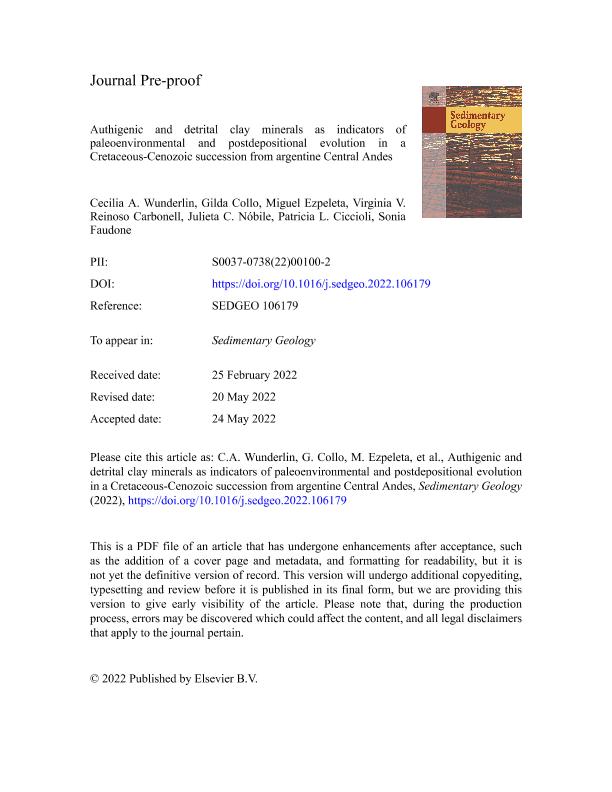Artículo
Authigenic and detrital clay minerals as indicators of paleoenvironmental and postdepositional evolution in a Cretaceous–Cenozoic succession from Argentine Central Andes
Wunderlin, Cecilia Ayelén ; Collo, Gilda
; Collo, Gilda ; Ezpeleta, Miguel
; Ezpeleta, Miguel ; Reinoso Carbonell, Virginia Valeria
; Reinoso Carbonell, Virginia Valeria ; Nobile, Julieta
; Nobile, Julieta ; Ciccioli, Patricia Lucia
; Ciccioli, Patricia Lucia ; Faudone, Sonia Nerina
; Faudone, Sonia Nerina
 ; Collo, Gilda
; Collo, Gilda ; Ezpeleta, Miguel
; Ezpeleta, Miguel ; Reinoso Carbonell, Virginia Valeria
; Reinoso Carbonell, Virginia Valeria ; Nobile, Julieta
; Nobile, Julieta ; Ciccioli, Patricia Lucia
; Ciccioli, Patricia Lucia ; Faudone, Sonia Nerina
; Faudone, Sonia Nerina
Fecha de publicación:
07/2022
Editorial:
Elsevier Science
Revista:
Sedimentary Geology
ISSN:
0037-0738
Idioma:
Inglés
Tipo de recurso:
Artículo publicado
Clasificación temática:
Resumen
New X-ray diffraction (XRD) data, scanning electron microscopy (SEM) analysis, and X-ray energy dispersive spectrometry (EDX) microanalysis on clay minerals are presented for Cretaceous–Cenozoic sedimentary sections studied in the La Flecha and La Troya Sur creeks, located in the Argentine Precordillera. The characterization of clay mineral assemblages, including the discrimination of detrital and authigenic phases, allows inferences to be made about paleoclimatic and paleoenvironmental conditions as well as the post-sedimentary history of these foreland clastic sedimentary depocenters. Mineralogical analyses carried out in the Cretaceous Ciénaga del Río Huaco Fm. and the Cenozoic Puesto La Flecha, Vallecito, Vinchina, and Zapallar Fms. show the presence of illites, smectites, illite/smectite mixed-layer clays (I/S, with R0 and R1 ordering types), sporadic corrensite, and subordinate amounts of chlorite and kaolinite, among other non-clay phases, such as analcime and heulandite. Illite and chlorite are interpreted as detrital phases, reflecting the composition of the source area, and smectite, I/S R0 and R1, and corrensite are interpreted as authigenic phases developed in the matrix or as massive pore filling within the clastic levels. Compositional analyses allow for smectites to be characterized as di- and trioctahedral Mg-rich, and are interpreted as a product of the combination of two main controls: (1) that from the parent material (volcaniclastic material and magnesian silicates) and (2) that of the primary composition of pore fluids associated with alkaline lake systems. These smectites are precursors of prograde diagenetic phases developed under a low thermal regime (<120 °C). R0 and R1 I/S formed from Mg-dioctahedral smectites mainly within the matrix, with an increase of illite % in R0 and R1 with depth, and corrensite formed from trioctahedral Mg-smectites mainly as massive pore fillings. Finally, the conclusions obtained from these new data reinforce that, in some cases, authigenic phases associated with mesogenesis (e.g., corrensite) would allow us to make inferences about the precursor authigenic material and therefore about some paleoenvironmental conditions. This, in turn, underlies the importance of making detailed analyses of clay mineral assemblages in reconstructions of the sedimentary and post-sedimentary history of basins close to areas with active tectonism, such as foreland basins.
Archivos asociados
Licencia
Identificadores
Colecciones
Articulos(CICTERRA)
Articulos de CENTRO DE INVEST.EN CS.DE LA TIERRA
Articulos de CENTRO DE INVEST.EN CS.DE LA TIERRA
Articulos(CRILAR)
Articulos de CENTRO REGIONAL DE INV. CIENTIFICAS Y TRANSFERENCIA TECNOLOGICA DE ANILLACO
Articulos de CENTRO REGIONAL DE INV. CIENTIFICAS Y TRANSFERENCIA TECNOLOGICA DE ANILLACO
Articulos(IGEBA)
Articulos de INSTITUTO DE GEOCIENCIAS BASICAS, APLICADAS Y AMBIENTALES DE BS. AS
Articulos de INSTITUTO DE GEOCIENCIAS BASICAS, APLICADAS Y AMBIENTALES DE BS. AS
Citación
Wunderlin, Cecilia Ayelén; Collo, Gilda; Ezpeleta, Miguel; Reinoso Carbonell, Virginia Valeria; Nobile, Julieta; et al.; Authigenic and detrital clay minerals as indicators of paleoenvironmental and postdepositional evolution in a Cretaceous–Cenozoic succession from Argentine Central Andes; Elsevier Science; Sedimentary Geology; 437; 106179; 7-2022; 1-59
Compartir
Altmétricas



